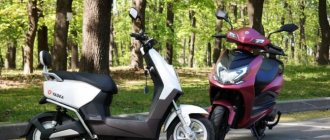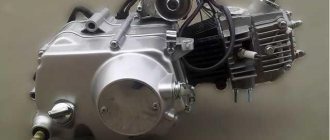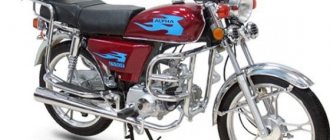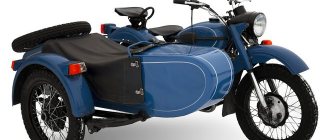Incorrect, the Alpha moped is one of the most popular vehicles in the post-Soviet space. And it’s quite easy to explain. After all, this model harmoniously combines high quality and affordable price. And the characteristics of the moped are excellent.
For every 100 km, the vehicle takes only about 2 liters of fuel. The weight of the model is 80 kg, the load capacity is 120 kg. These indicators are already quite good, at the same time, there are also opportunities to improve the device. We will talk about how to tune this moped in the article .
Tuning features
The topic related to Alpha tuning is quite common, since there are many ways to improve the quality of this moped. At the same time, the cost of modernization will be an order of magnitude lower than in the case of a similar Chinese scooter. After all, Alpha is made quite simply, so access to the power unit and external elements is as convenient as possible.
The model can be improved in various directions, so before starting work you need to decide on the qualities that you want to change. Another important nuance is that you should understand the difference between styling and tuning. The first involves solely changing the appearance, while the second option also affects the functional parameters of the vehicle.
In addition, many see tuning an Alpha moped not just as a task to improve certain characteristics, but also as a real hobby that can keep the owner busy. There are many improvement options, and you can also use your own ideas that optimize the functionality of the device. Now we will focus on each specific area.
It will also be interesting: Tuning the IZH Planet 5 engine for those who love their IZH
Video review of the Alpha moped:
How to change gears on a motorcycle correctly
All movements you make with the pedals must be smooth so as not to damage the transmission.
When changing gears, change one speed at a time. It is not advisable to jump.
To understand how to change gears on a motorcycle, you need to carefully study the controls. There are motorcycles with manual transmission and semi-automatic.
Method one
Motorcycles with manual transmission. All actions in this case occur in the following sequence. Pick up speed. Take off the gas. Engage the clutch. Press the gear shift pedal. Release the clutch, then the shift pedal and add gas.
To start the motorcycle, place it in neutral. After this, remove the gas and squeeze the clutch, at the same time turning on first gear. Taking your foot off the gear pedal, apply gas and release the clutch. Now add gas.
To upshift, you need to lift the gas, engage the clutch and press the gearshift pedal. After this, release the clutch, release the shift pedal and add gas.
To downshift, you need to remove the gas and engage the clutch. After this, sharply add gas, and when the speed begins to drop, press the gearshift pedal. Release the clutch and shift pedal and add gas. Once the motorcycle has stopped, be sure to put it in neutral.
Method two
Motorcycles with semi-automatic transmission. On these motorcycles, gear shifting is easier. Take off the gas and change gears. The clutch and gearbox are connected here.
Before starting the engine, place your bike in neutral. In order to engage first gear, you need to remove the gas and press the gear lever down. To increase the gear, you need to remove the gas and lift the gear lever up. To downshift, on the contrary, you need to apply gas and immediately remove your hand from the gas. When the speed starts to drop, change the speed and add gas. Now you know how to change gears on a motorcycle.
Improved appearance
Probably every vehicle owner wants his car to look as attractive as possible. That is why tuning mopeds is most often aimed at improving the overall design. At the same time, you can optimize not only the appearance, but also the overall functionality of the model. Some of the most common improvements include:
- replacing the seat with a wider and more comfortable model;
- installation of special panels that protect the legs and also prevent fractures;
- installation of wider wheels (this leads to increased stability, which is especially necessary when replacing the power unit);
- windshield installation. This will help improve your riding comfort. At the same time, such an accessory negatively affects the aerodynamic properties of the model, especially when driving at speeds of 40 km/h or more;
- replacing disks. Here we are talking mainly about aesthetic preferences, since the basic discs are also quite good;
- replacing the plug. Such a solution is necessary if you often drive on rough roads or off-road. By strengthening the shock absorbers, you can significantly reduce the load on the wheels;
- replacement of lighting. New LEDs will be a great option, as they shine brightly and look stylish. But you should not buy xenon lamps, since their quality is not much better, but they will dazzle passing drivers, which can increase the likelihood of unforeseen situations on the road;
- installation of rear view mirrors. The factory model looks quite unpresentable, so new mirrors will greatly change the appearance of the model. Additionally, turn signals can be installed on them, which increases the practicality of the devices.
Finally, it’s time to start painting your iron horse. The choice here is simply huge, so you can give your moped the style you've always dreamed of.
You may also be interested in: Three-wheeled motorcycles are quite rare today
Cylinder-piston group.
Finally, the most effective improvement for any engine is replacing the CPG. But not just a replacement, but the installation of a new, larger piston. Fortunately, there are now many ready-made kits on the market; you don’t have to sharpen or adjust anything, as with Soviet equipment. Moreover, there is even a lot to choose from. For example, for various models with a volume of 50 cubic meters, they offer kits to increase to 63, 72, 82 and even 90+ cubic cm. In some cases, this is an almost double increase in power.
The situation is similar with larger engines, for example, for 125 cubic meters, sets of 150 or 170 cubic meters are sold. Some, in the process of tuning a scooter, manage to increase 150 cubic meters with their own hands to 225 cubic meters. Choosing the right part is not the most difficult thing, the most difficult thing is installing it. After all, this process involves almost complete disassembly of the engine. You will be faced with the need to have several special removable keys in your arsenal; you can ask them from friends or borrow them for the evening at auto repair shops. We strongly recommend studying the technical component in order to properly disassemble, replace the necessary elements and assemble the motor.
Alas, for some, increased power does not promise anything other than breakdowns or inadequate performance. This is because by significantly increasing power, you inevitably entail work on all other nodes. Let's imagine that we installed a new 92 cc CPG on an old 50 cc engine. The first thing to check is the condition of the connecting rod, crankshaft and bearings. Otherwise, they will fly first, followed by our new system of both cylinder and piston.
Great, we added new bearings to the CPG, an elbow with a connecting rod, now we can be sure of reliability. But the engine does not go faster, and we decide to purchase a new carburetor. Now the mixture is too rich, and we understand that the exhaust needs to be changed. After such modifications, the engine sounds loud, accelerates perfectly, but the maximum speed is slightly higher than before and the variator sounds strange. After installing a high-speed CVT, for example from the Italian manufacturer Polini, the engine will be able to fully realize its new power. The last stage is an inspection of the brake system; you don’t want to find out at a speed of 60 km/h that the brakes are now comparable to bicycle ones.
As a result, after replacing almost all the components, we got a very fast “flea” that can surprise your friends and experts in this technology. Over time, you can make changes to the chassis system, replace shock absorbers, and install more attractive wheels. Often, the modernization process does not stop there, and after tuning a scooter 50, 150 with your own hands, impressive improvements in appearance are made. The moped is repainted, panels are changed, new devices, lighting, and so on appear.
Volume expansion
The starting volume of the engine can be increased up to 110 cubic centimeters. At the same time, you need to understand that such a decision will lead to the need to register your vehicle. But it’s worth it, because the engine will begin to behave an order of magnitude more powerful and dynamic. In addition, when tuning a moped, it is also worth replacing the low-quality pistons that come with the kit. This will also have a positive effect on the operation of the engine. Thanks to the new engine, you can significantly increase the speed of your model. In fact, the Alfa will turn into a real motorcycle, and will not be a compact moped.
When replacing a cylinder, you can use components from Delta or Active. On the other hand, then you will have to change not only the cylinder, but also the crankshaft, chains, seals, rollers and, quite likely, even the carburetor.
We adjust valves (4t engines).
As mentioned earlier, the engine must be serviced before boosting. Work that will help improve dynamics includes adjusting the valves. The procedure is suitable for tuning Chinese 4t scooters and other 4-stroke engines. For small-capacity equipment, it is recommended to carry out such adjustments at least once every 3, and preferably once every 2 thousand km. It is also necessary to carry out adjustments after manipulations with the CPG.
Before you begin, you need to make sure that the engine has completely cooled down and that you have a set of keys (8,9) and feelers of 0.05 for the intake valve and 0.07 mm for the exhaust valve at hand. You can get to the adjusting nuts by first removing the valve cover. When access to the valves opens, the piston is installed at top dead center. Next, a feeler gauge is installed in the intake valve gap and, depending on the current position, an adjustment is made.
To increase or decrease the clearance, you need to loosen the lock nut (while holding the adjusting bolt), turn the adjustment bolt and, while holding it, tighten the lock nut back. Thus, we achieve a gap when the probe passes into it with little effort. After adjustment, make a full revolution of the crankshaft and make sure that the adjustment is accurate.
Replacing sprockets
To make the motor work more efficiently, it is also worth replacing the sprockets. This will help further increase the speed of the device. But for the result to be noticeable, it is necessary to mount a 16-tooth sprocket and an enlarged cylinder. This combination is the most optimal.
In addition, you should take a closer look at the condition of the chain. If it is worn or damaged, the sprockets will also wear out faster.
Procedure
There are several effective ways to increase moped performance such as speed and power. The most popular of them should be described:
- Using a screwdriver, unscrew the side and rear plastic from the moped.
Under them you will find a belt responsible for transmitting speed to the rear wheel and both sprockets. Above this belt you will see a small metal washer (speed controller) that limits the belt to a larger radius.
You need to knock this puck down with a hammer, and then try to pick up speed. If your moped has an engine capacity of up to 75 cc. see I was able to accelerate to 70–75 km/h, which means you succeeded.
Unscrew the fastening of the transmission mechanism and remove it from the moped. Then, without sudden movements, try to remove the belt, having previously stocked up on a new larger rear sprocket (the new spare part can increase the torque). Put the belt back on and try to pick up speed.
With proper modification of the scooter, you can increase the maximum speed of the vehicle to 120–140 km/h, however, for this you will need to attach a new washer, which will protect you and will not create difficulties during the technical inspection.
Fastening the washer above the belt in different positions will allow you to adjust the maximum speed of the moped.
The higher the puck is, the higher the scooter's speed will be. Try to empirically find the position of the washer at which the max. the speed would be 95–100 km/h.
After all this is done, when you reconnect the gearing, put the plastic back in place and try to get up to speed, you will find that the top speed will be higher and the acceleration will be smooth and slow.
The only disadvantage of such actions will be a natural decrease in traction, as a result of which you will not be able to normally drive up hills with an inclination angle of 20 degrees or higher.
Running in an improved moped
After the engine has been upgraded, you should start running it in. At the same time, it is better to develop maximum speed in deserted places. Sometimes it happens that the suspension and braking systems cannot cope with the increased power of the power unit, so you will have to use a parachute to brake. If the silent blocks begin to fall out while driving, then the shock absorbers, fork and brake system should be replaced.
You may also be interested in: Girls on motorcycles or bikers in skirts
Cleaning the cylinder, boring windows.
Improvement suitable for scooters with two-stroke engines. Their peculiarity is that very often the casting inside the drain and exhaust channels is defective, that is, it has roughness. These shortcomings lead to the fact that the piston is not blown through properly and, accordingly, loses power. Having removed the cylinder and armed with a rolling cutter, you can polish the channels, and then round off the sharp edges on the inside. When tuning scooters, in the photo you can see the differences between the motor before and after polishing. This action will help make the engine work easier at high speeds and potentially add a couple of kilometers to the top speed.
You can go further and increase the diameter of the inlet/outlet windows. For each 2T engine, this parameter is calculated individually. For example, it is enough to bore some 50 cc engines by 1 mm to obtain optimal intake/exhaust parameters. Do-it-yourself tuning of a 150cc scooter and other engine sizes is done in the same way.
A short summary
So, if you have an Alpha moped, tuning this vehicle looks like a good option to improve the functionality and power of the model . This kind of work is often very interesting, so it will bring you a lot of positive emotions. Moreover, the design features of the moped provide convenient access to the main components, as a result of which improvements can be made in almost any direction, even without special knowledge in the field of auto mechanics.
Video advice on modifying the Alpha moped:
Advantages of the model
Some characteristics of this Chinese model are in many ways superior to those of two-seater mopeds. Thus, the Alpha moped is equipped with an ergonomic passenger seat and a spacious trunk. The seat is extremely comfortable and even two adult men can fit on it.
Another advantage of the Chinese model is that it makes even steep climbs relatively easily and confidently. Thanks to the 4-speed gearbox, a skilled driver can get the most out of the powerful engine.
The electric starter, with which you can start the moped in case of force majeure, is of high quality.
Comfortable travel on an Alpha moped
One of the main advantages of the model is the comfort of movement. This allows you to travel even over long distances. The seating position is quite comfortable and high, the footrests are where they should be, and the steering wheel has the correct smooth curve.
The dashboard is very informative. The large size of the tachometer and speedometer allows you to quickly read the indicators in any weather conditions.
What is interesting to the consumer
Why are city residents interested in the Delta?
The popularity of this model should be sought in the technical characteristics of the vehicle:
- Electric starter;
- More than moderate appetite - 2.5 l/100 km;
- Four-speed semi-automatic (for Delta Racer model);
- Load capacity 100 kg;
- Easy to maintain with your own hands;
- More than reasonable price for the model itself and spare parts.
Another electrical connection diagram from the spare parts catalog for Delta
Not enough speed
If the maximum speed is not enough, we change the gear ratio. You need to put a sprocket with fewer teeth on the rear axle. If there is not enough chain adjustment flow, it will have to be shortened by several links. Overclocking characteristics will change. The first gear will become shorter, but by switching to higher gears and spinning the engine to the maximum, the increase in speed will be noticeable. The maximum speed will increase by ten to fifteen kilometers per hour. By the way, you shouldn’t turn the first gear until it “squeals”. Overheating can cause the bushing in the clutch to become stuck and the neutral will disappear, if not forever, then certainly until the entire clutch crown is replaced.
Inspired by Philips MP1002C
In the mid-80s, I had the pleasure of witnessing testing of a Philips MP1002C generator set that actually worked. The experience made a deep impression on me, especially in how calmly the Stirling started up and came to life. The maximum noise came from the burner (combustion chamber), but ultimately the Philips engine produced a very pleasant sound background - all that needed to be replaced were the noisy bearings.
As the old saying goes, “It worked and worked like a Singer sewing machine!” At the time, my experience with Stirling engines consisted of designing a few bench-top sized models, but after seeing and hearing a Philips engine in action, I wanted to design, design and build an engine of the same caliber...make something large enough that it would produce a useful, perceptible work.
Shifting up gears with clutch
To understand the upshift technique, perform the following experiment. Drive in second gear with the throttle slightly turned off. Now, without closing the gas handle - squeeze the clutch - you will see how the revolutions instantly rise. Close the throttle. When the load in the form of the rear wheel disappears, nothing prevents the engine from spinning up and the speed increases rapidly. That is why speed in gear shifting plays an important role. If you shift quickly, then you may not close the throttle; at the moment when the clutch is depressed, the speed rises and immediately the gear shifts up and the clutch returns. If you do this quickly, then the revolutions rise by only 1000-1500 to provide optimal conditions for upshifting with the clutch.
To change gears up with the clutch, you need to quickly squeeze the clutch, shift up and release the clutch so that the revolutions at which the next gear is engaged do not exceed the revolutions of the gear from which you are shifting by more than 1500. If you do this slowly, you need to close the throttle at the moment when the clutch is depressed, if quickly, you can hold the handle in the same position or barely close the handle. An important criterion is the speed at which you started shifting up and the difference between the speed at which you depressed the clutch and at which you released the clutch - the difference should not exceed 1000 - 1500 revolutions. With practice, gear shifting will become automatic and will not require attention.
Start
The most difficult element for a beginner motorcyclist. Shift the gearbox to neutral. Make sure your elbows are bent and your center of gravity is forward. Depress the clutch. Engage first gear. From idle speed, smoothly release the clutch handle while raising the speed. If your motorcycle is equipped with a clutch lever position sensor (for example, Suzuki fuel-injected motorcycles), then you may notice how when starting from neutral the motorcycle itself adds speed - making it easier to start. Do not drop the clutch lever. Once you have mastered the soft start, you can learn to start faster. The principle of a fast start is the same as for a slow one - you load the front, your arms are bent, but the start does not start from idle speed, but from rpm from 4000 to 8000. The optimal start for a beginner in the city is to start from 3000 rpm. When starting, we recommend keeping your right foot on the rear brake - if you miscalculated the speed and the motorcycle begins to climb onto the rear wheel, use the rear brake. Often, we start where we end. Traction control when starting a motorcycle, using the rear brake, is widely used by riders when starting a motorcycle in world championships.
What is the benchmark - what is the fastest start. The fastest start is when you lie on the tank and throughout the entire acceleration line your wheel is torn off by 0.5 - 1 cm from the ground level. Taking into account bumps, this element is quite complex and, often, for its practical implementation, electronics are installed in motorcycles that control the unloading of the front wheel. On motorcycles equipped with a quick start, you can start with the throttle fully open; the electronics analyze the load on the front fork and automatically turn off the ignition as the fork becomes too unloaded. From the pilot's point of view, it looks like this: you load the front, lie down on the tank, fully unscrew the throttle and practically drop the clutch - the electronics do the rest. 99% of motorcycles are not equipped with a quick start and the pilot has to do the electronic work.
The main criterion for a successful start in the city is constant engine speed as the clutch releases. As you release the clutch, the revs begin to drop and you should try to keep the engine revs constant by opening the throttle at the same time as releasing the clutch. If you managed to do this, you can move on to the next step - reducing the clutch release time. After this exercise has begun to work out, try starting at high speeds, loading the front.
Ignition circuit elements.
Electronic tachometer on the dashboard.
When the turn signals are on, it makes characteristic clicks with a frequency of about 1 Hz. Also, you cannot replace lamps with more powerful ones. Due to the electronic circuit of the regulator, the voltage on this wire is converted into a pulsating one, and is supplied to powerful current consumers - low and high beam lamps, as well as dashboard backlight lamps, there may be several of them.
This is what the relay regulator looks like on a scooter. Due to its primitive circuitry, the relay-regulator often fails. Basic Concepts In order to understand wiring, you need to understand a little about the types of current. The starting relay receives a thick red wire from the positive terminal of the battery. The alternating voltage is removed from the white wire and supplied to the relay regulator for subsequent straightening and stabilization.
Lacks low end and traction power
You will have to disassemble the motor and change the technical specifications. Alfa moped engine tuning is provided with components of different prices and quality. A motor of this configuration is an exact copy of a Honda motor that has been produced for many years. There are clubs for moped lovers with this engine all over the world. Road races, enduro and off-road races are held. And, as a rule, where there is serious sport, there is civilian tuning. Forged piston and connecting rod, four-valve head with Ducati-style desmodromic mechanism, dry clutch, water cooling. The injection system is from Yoshimura... But since we are now talking about an Alpha moped, the price of which in the store is less than the cost of any of the listed components, our tuning option is more modest.
Alpha engine tuning
Engine tuning can be immediate aggregate or unit and stage-by-stage. On sale you can find engines with the same method of mounting to the frame, but with a volume of 110 cc, 125 cc or 150 cc. An increase in engine capacity will entail the need to register with the traffic police, but this is an organizational issue. The technical side will be as follows: the electrical wiring remains the same, a larger engine will require a different carburetor and a different exhaust pipe. Most likely, they will be found in the same place as the motor itself.










